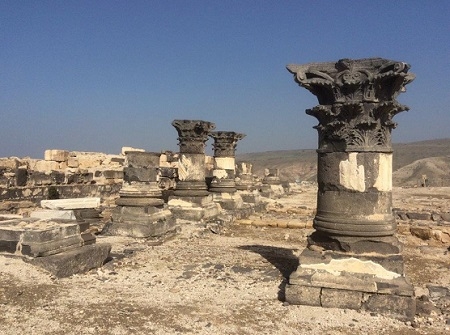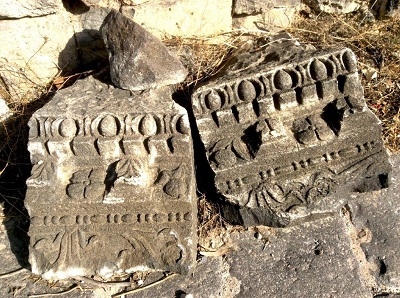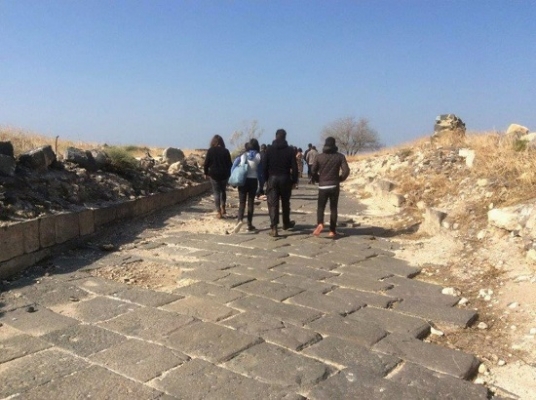New Life for ‘City of the Horse’
Perched 350 meters atop a strategic hill overlooking the eastern shore of the Sea of Galilee, directly above Kibbutz Ein Gev founded in 1937, are the remains of the City of Hippos ("horse" in Greek), also known as Susita, founded during the Hellenistic period in the second century BCE.
Originally settled by pagans who later converted to Christianity, a small Jewish community is known to have also settled at Susita. It is a short distance from another archaeological site where an amazing reconstruction of an ancient synagogue is underway – one of 25 ancient synagogues already discovered on the Golan.
Known as Umm el Kanatir (Mother of the Arches) the synagogue and other buildings at this site were built from black basalt stone. Thousands of the huge stones have been numbered and photographed using high-end technology. Experts have already completed a virtual rebuild with the help of archaeologists, engineers and many able hands using a mobile crane alongside enormous bright yellow steel girders and pulleys constructed over the site, believed to have been established in 23 BCE.
Relatively close by, the grand remains of the city of Susita are spread across a diagonally shaped expansive hill with an extensive plateau. They are connected by a steep narrow ridge giving access to the site where one is treated to the incredible sight of scores of impressive, beautifully carved ornate stones and pillars that have been excavated and restored. Other stones strewn over this breathtaking site dating back to the Roman and Byzantine periods are waiting their turn for the same tender, loving care.
One needs to climb up the steep slopes on a well-marked path of the ridge upon which sits Susita-Hippos from the back. The views en route to the plateau are amazing - to the left, one takes in the eastern shore of the Sea of Galilee and across the waters to Tiberias and on the right, undulating hills and dales of the lower region of the Golan mountain range.
However, it is a bit daunting to see on either side of the rocky pathway somewhat bent, misshapen yellow and red signs, attached to rusty barbed wire fencing, warning in Hebrew, Arabic and English, of the dangers of straying from the path … and into a minefield! Oy vey.
One of the first archaeological artifacts of importance one comes to is a portion of the city gate and hewn rocks that were part of an extremely sophisticated water system. Here, one begins to tread on huge dark grey paving stones hewn thousands of years ago. It is clearly the main road, taking one for hundreds of meters into and up to the main square and a deep reservoir. The piles of basalt and granite pillars that one passes would have been part of a church or two. They now look like they have been chucked around willy-nilly by some gigantic Scottish saber tossers.
Below, jutting out from the graded slopes, archaologists are still working on uncovering Roman soldiers' quarters and steam bathhouses. It is obvious there is still a great deal to be discovered at this wondrous, off the beaten track site - a city that that changed hands again and again during its thousand years of existence.
Apparently destroyed by an earthquake in 749 CE, Susita-Hippos was not inhabited again by a civilian population until 1948 and the War of Independence when members of Kibbutz Ein Gev, founded a decade earlier on a very narrow, flat piece of land on the eastern shore below, decided to take control of the overhead ancient fortification, which at the time was manned by a few dozen Syrian soldiers.
"Some 30 members of the kibbutz during a night-time operation took Susita from the Syrian soldiers that were here and it literally became a front-line military command post until the war of 1967," explains British born guide James McKeever, who made aliyah seven years ago, served in the IDF and lives with his Ein Gev born wife and young daughter at the kibbutz.
"The kibbutzniks carried out a 3-pronged attack, one of which came up directly from below in the center and caught the attention of the Syrians but at the same time the other two groups came up from either side and thus overran the soldiers stationed there," said James, a self-confessed history nerd.
From the edge of the plateau looking down on the kibbutz buildings, one sees the rusty remains of the hoist and pulley system set in place in the late 1940s to supply food and water to the few kibbutzniks who kept an eye on the stratigcally significant hilltop, which dangles over the steep rock faced precipice, swinging to and fro as a ferocious, cold wind whips through the site.
Looking over and out across the Kinneret, to the right of Susita another pointed and strange shaped hill holds a commanding position over the area. This hill, one learns from James, is the marker for the 1916 Sykes-Picot Agreement between the British and French.
Upon climbing the steep ridge and entering Susita, apart from the remains of the city's main gate, a guard post built by the kibbutz members comes into view – perched over ancient basalt pipes that were part of a 25 km. long aqueduct. A few meters from that vital until 1967 position, sits another portion of the rusty fence and mine field warning signs.
"Members of the kibbutz, not the IDF, kept this position, the most eastern position, from 1948 until 1967," explains James to a group of young people hailing from many different countries and presently volunteering at Kibbutz Geva in the eastern portion of the Jezreel Valley, including James' younger brother Ralph. I was invited to join the group for the day by the Geva volunteer coordinator Brenda Landes, who is originally from Cardiff, South Wales.
The importance of taking Susita-Hippos from the Syrians in 1948 (2 millenium after it was founded) is obvious to the present-day observer. Even so, Syrian soldiers ended up extremely close to them as they sat perched on other daunting vantage points along the Golan ridge above the kibbutz members who, until the 1967 war, were often shot at as they worked the fields or returned to the kibbutz harbor after a day out fishing in the Sea of Galilee. Shells also rained down on the kibbutz from time to time and the kibbutz kinder knew well what it was to sleep in underground shelters during those more than harrowing times.
Present day Ein Gev is a picturesque kibbutz attracting tourists, both Israeli and from overseas. Famous for its fish restaurant and excursions out on the waters of the Kinneret, a pleasant lakeside promenade has been developed in the name of one of Ein Gev's founder members who later became the mayor of Jerusalem from 1965-1993, Teddy Kollek.
As one strolls along the harbor promenade on the tranquil shore, signs in Hebrew and English give visitors important information about the founding and development of Ein Gev. Visiting the kibbutz after walking around Susita-Hippos overshadowing that community, the incredible story of the kibbutz, the struggle to farm, fish and bring up families under bombardment until 1967, makes for powerful reading and a deeper understanding and appreciation of the grit and determination of those founder members and subsequent generations to stand their ground and succeed.










Comments